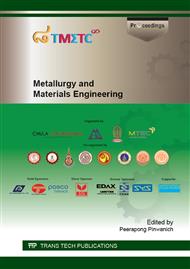p.14
p.19
p.25
p.31
p.36
p.42
p.53
p.59
p.64
Direct Observation of Liquation in Ni-Base Superalloy by Using Confocal Laser Scanning Microscopy
Abstract:
In-Situ direct observation was used to observe the liquation in an Inconel 617. High-Temperature Confocal Laser Scanning Microscopy (HT-CLSM) was used to observe the phenomena. Experiment was perform at 1330 °C with heating rate 5 °C/s. Results showed that the liquidation started at 1319.2 °C (268.08 seconds) in which liquid formed around precipitate. At 1330.5 °C (272.05 seconds) the liquid film wet and penetrated along grain boundaries. Then after 277.05 seconds, sufficient liquid film formed and moved freely on the surface of the specimen across grain boundaries. After cooling to room temperature, the test specimen was analyzed for local chemical composition gradient of precipitates and liquid film. Precipitate morphology changed from polygonal shape to round shape using SEM and EPMA. The results from this observation could be used to explain liquation mechanism occurred in Inconel 617 during heating.
Info:
Periodical:
Pages:
36-41
Citation:
Online since:
July 2015
Authors:
Keywords:
Price:
Сopyright:
© 2015 Trans Tech Publications Ltd. All Rights Reserved
Share:
Citation:


